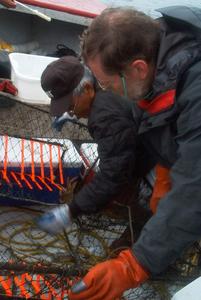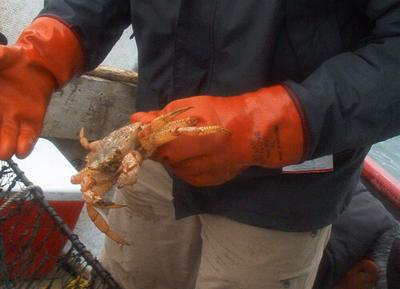
|
|
6 July, 2003
Choppy day on the Chukchi Sea
Today on the Kotzebue Sound and
beyond
The weather is overcast with scattered sprinkles.
Despite the fact that it is mid 50’s in town, on a 20ft boat with wind
and sea spray in the face, it seems a lot colder.
What Science Is Happening?
On the boat again, but this time 2 hours away on a very choppy
ocean we stopped to take samples. We took water samples at the surface
and part way down, these will be tested to find out how much
chlorophyll (plant material) is there. Just like when we sampled the
ice in April, we dropped a Sechi Disk to see how far down the water was
visible. We tested for Conductivity (how much salt is in
the water), Temperature, and Depth with the
CTD diver. We took samples in a zooplankton (animal
plankton) and phytoplankton (plant plankton) net. All the readings
that we took will tell us if different animals live at different sites,
this ties into our second hypothesis, The effects of sewage in the
Kotzebue Sound. If the animals or plants are different were the sewage
is being dumped then we can predict the effects long term.
Melinda, Dr. Will Ambrose and Kate continued on to hunt for the clams
that eluded us yesterday, but I was let off at the shore and sent home
to rest up from my sea-sickness because we are out again tomorrow and
scientists have to get the work done, even if they get sick.
Classroom Connections:
Take out a map, any map, a road map, a map of the U.S., Europe,
anywhere. Look along the lakes, rivers, ocean edges and waterways.
What do you see? Really look, no peeking! Ok, you looked? Then you
saw cities and towns. Probably old cities, maybe your city. The
oldest cities are along the water, why do you think that is? The
earliest settlers needed a constant source of water and food. Later,
water ways were used for transportation of goods and to irrigate (bring
water to)crops. People also started using the waterways to take away
their garbage, sewage and factory waste. When you get a meal, it
probably comes from the super market, but most people in Kotzebue still
fish and hunt sea mammals for their food. Why do you think that they
are concerned about the dumping of sewage?
Reflections
Today we went out to
the Cape Krusenstern across the Kotzebue Sound by boat. This is the
same place I went by snow machine on April 25. No two trips could have
been more dissimilar. Even though a couple valleys still had a dab of
snow, the views were completely different. With the difficulty in
sampling in the choppy sea, the bone-jarring boat ride and the
seasickness, I have to admit, I prefer the ice!
Links
Learn
more about our project here
View curriculum for this project, “Ask a Scientist” and
learn about other Arctic Real Time research at Arctic Alive
City of
Kotzebue Webpage
Listen to the local radio station KOTZ live

We need to carefully mark the bottles with the location and date that we are taking samples before we leave.

Will Ambrose and John Goodwin, our captain, are pulling up traps looking for sea creatures. These benthic life forms will be tested to determine what they are eating. Do you think what we find will match with what the elders, hunters and fishermen tell us about the local wildlife?

First specimen of the day.
Contact the TEA in the field at
.
If you cannot connect through your browser, copy the
TEA's e-mail address in the "To:" line of
your favorite e-mail package.
|







